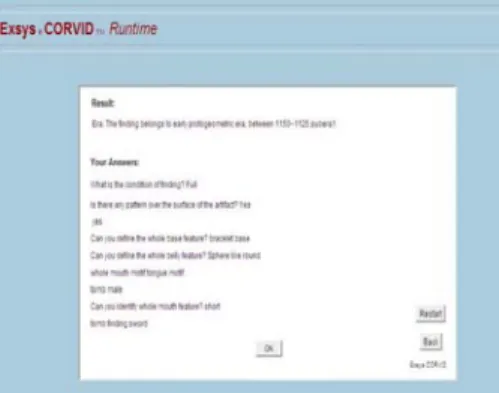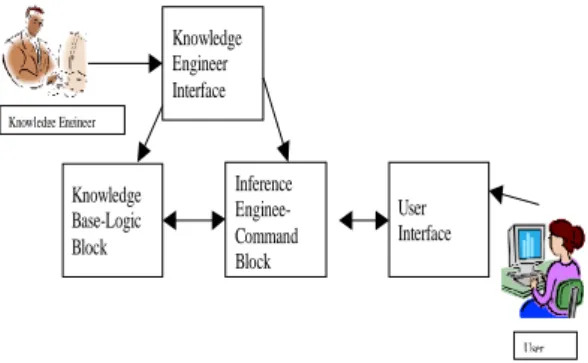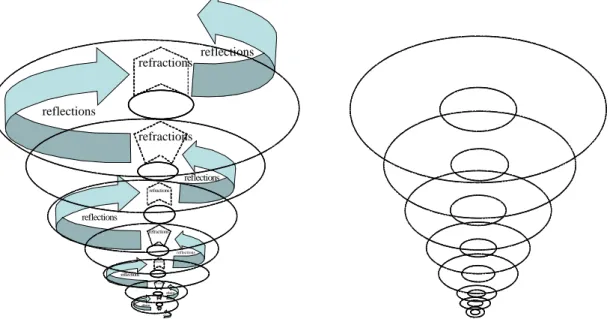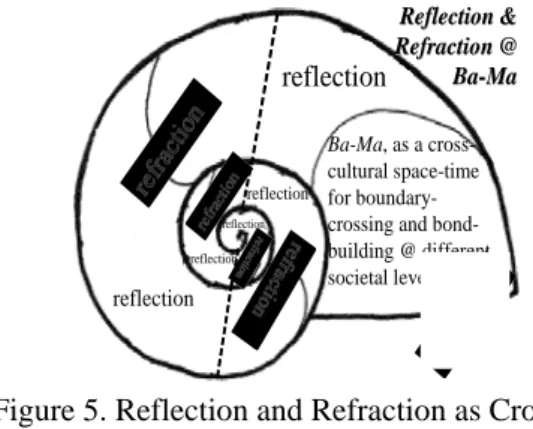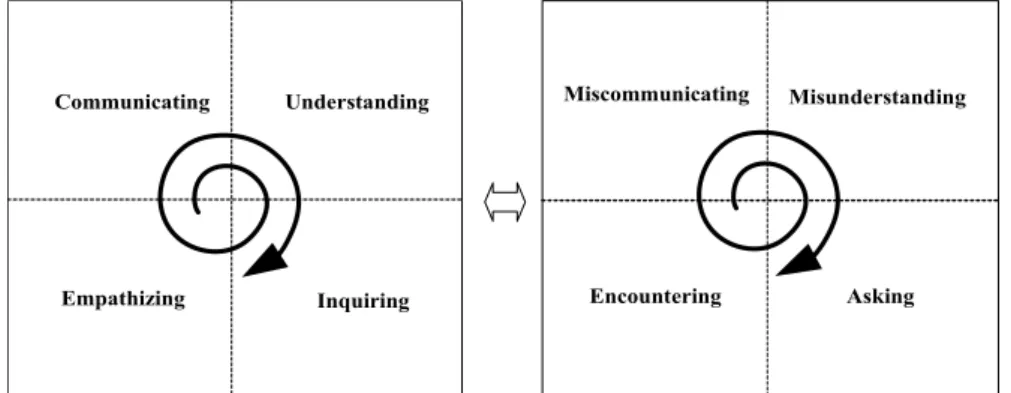Japan Advanced Institute of Science and Technology
JAIST Repository
https://dspace.jaist.ac.jp/Title Amphorae Knowledge and Knowledge Amphorae for Cross-Cultural Knowledge Management
Author(s) Medeni, hsan Tolga; Tolun, Elif F.; Medeni, Tunç Durmu
Citation
Issue Date 2007-11
Type Conference Paper
Text version publisher
URL http://hdl.handle.net/10119/4129
Rights
Description
The original publication is available at JAIST Press http://www.jaist.ac.jp/library/jaist-press/index.html, Proceedings of KSS'2007 : The Eighth International Symposium on Knowledge and Systems Sciences : November 5-7, 2007, [Ishikawa High-Tech Conference Center, Nomi, Ishikawa, JAPAN], Organized by: Japan Advanced Institute of Science and Technology
Amphorae Knowledge and Knowledge Amphorae for Cross-Cultural
Knowledge Management
İhsan Tolga Medeni†, Elif F. Tolun‡, Tunç Durmuş Medeni*, †‡ Çankaya University, * Turkey, JAIST, Japan
tolgamedeni@hotmail.com, eotolun@cankaya.edu.tr, tuncmedeni@gmail.com
Abstract
Based on questioning the link between knowledge and amphorae, this paper consists of two distinct parts. The first part presents an expert system which is built to use in the Archeology field, highlighting the need for the knowledge systems to reveal knowledge of anthropology. With this expert system we try to categorize Protogeometric Era Amphorae. We define some of the basics for
Protogeometric Amphorae characteristics to build
our expert system. Then we present our
Protogeometric Amphorae Classifier as a
candidate expert system. The second part theorizes a knowledge amphorae perspective for knowledge science, musing in an academic metaphoric way about knowledge. With a switch from archeology, we draw upon a set of concepts derived from geophysics for this knowledge amphorae perspective. As a result of such perspective, conceptualizations of reflection and refraction for knowledge are also developed. While these two distinct parts that represent the different approaches of the contributing authors are discussed together, we hope to present the importance of knowledge in anthropology, as well as the importance of anthropological and geophysical knowledge for knowledge science. Key Terms: Protogeometric Era Amphorae Classifier, Expert Systems, Knowledge Amphora, Reflection & Refraction, ba & ma
1. Introduction
In a time where knowledge becomes the most important asset, human knowledge about any physical material has been carried to digital bases
to support our daily routines. Consequently, the cross-cultural interactions and interconnections among technologies of knowledge-support software such as expert systems, the daily routines of our social practice and human nature, and the theoretical modeling of the practice become more significant.
We hope our article provides an example account of such cross-cultural interconnections among different disciplines and perspectives, hoping to achieve a twofold purpose: 1) to build both an Expert System for protogeometric amphorae classification, and knowledge amphorae modeling for knowledge 2) to trigger some creative reflection for the reader, superimposed on the knowledge question, showing even distinct fields can be all interrelated. Contributing as co-authors with distinct perspectives, we first introduce Protogeometric Era and Amphorae, as well as our expert system to identify different types of amphorae; second we theorize a knowledge amphorae perspective for knowledge science, underlining reflective and refractive interactions; before we conclude our article.
2. An Expert System Implementation Revealing the Knowledge of Anthropology for Amphorae
One of the interest areas of Archeology is defining the findings and separating them from each other, according to the features that are used by archaeologists to make classifications. Expert systems, with given inputs, used by scientists can easily identify the findings, especially when finding an expert related to a specific era is a difficult task. Archeology is a very large area, so
there are some research topics that need the touch of expert systems and knowledge science.
In our research, we try to construct a specific expert system to classify Protogeometric era amphorae. Our software does exactly what an expert would do, in a consultation about the specifications, age and types of pottery.
2.1 Protogeometric Amphorae
The Progeometric age began in 1150 and lasted 150 years, and ending in 1000 BC, after which the geometric age began. The Amphorae from this 150 years’ era may be subdivided according to the positions of their handles. There are four different types, according to this division: 1) The neck-handled amphora, where the handles rise, usually vertically, from the shoulder, and are molded on to the neck, below the lip. 2) The belly-handled amphorae, where the handles are placed horizontally, usually at the point of greatest width on the belly: these handles are normally single, but occasionally double. 3) The shoulder-handled amphorae, where the handles are placed vertically on the shoulder. 4) The amphorae with handles from the shoulder to lip.
In Attica (archaeological place in Greece), inside tombs the amphorae are used to keep the ashes of the dead. But sometimes it is difficult to find whole amphorae, only some parts have remained. Conditions in the tomb, the accessories and the remaining parts of the amphorae help us to define the amphorae.
According to anthropological evidence, types of the amphorae change according to the type of the tomb. Especially, neck-handled amphorae are found in male tombs and belly-handled amphorae are found in female tombs. The evidence of this conclusion is the other items that were found with the amphorae. We may presume that weapons, swords, spear heads, large knives and shield bosses belong to the male burials. On the other hand, dress pins, as far as observed when excavating a sub-Mycenaean cemetery, are female ornaments. So, even if the amphorae are found in broken pieces, the other findings of the tomb can clarify the nature of the amphorae.
The protogeometric age is investigated in essentially three periods. Those are 1) Early
protogeometric, 2) Middle protogeometric and 3) Late protogeometric.
The early protogeometric begins at 1150 (BC) and ends at 1100 (BC). The middle protogeometic begins with the end of the early protogeometric and lasts until 1050 (BC), the beginning of the late protogeometric, and 1000 (BC) is the end of the age.
In this project we also divide those periods into sub-periods. Those sub-periods are the times of the appearance of small changes in the characteristics of the amphorae. The sub-periods are as follows: 1) Sub1 begins 1150, ends 1125; 2) Sub2 begins 1135, ends 1112; 3) Sub3 begins 1112, ends 1085; 4) Sub4 begins 1090, ends 1060; 5) Sub5 begins 1062, ends 1020; 6) Sub6 begins 1030, ends 1010; 7) Sub7 after 1010.
For determining the age of an amphorae, some criteria are used. Those are; 1) Foot of the amphora, 2) Body and shape of the amphora, 3) Figures on the amphora, 4) Dimensions and the diameter of the arc of the neck.
Foot of the amphora: Especially, two types of
feet are the characteristic of the protogeometric amphora. In early protogeometric periods, ring foot is the model, but after the middle period, conic foot came into use.
Body and shape of the amphora: The body can
be spherical or ovoid, tapering at the foot. The circumference of the body, at early age is wide, and as time progresses it becomes narrower, and the ovoid shape comes into existence.
Figures of the amphora: The figures in the first
designs of the protogeometric period are wavy lines on the body and around the neck. Tongue motif accompanies the wavy lines. From the beginning of Sub-period 2, concentric circles can be seen. At the end of Sub-period 3, dog teeth motif has been added to the patterns. The later figures of the (semi-)concentric circles and sand-clock motif inside these semi-concentric circles are the features of Sub-periods 6 and 7.
Dimensions and the diameter of the arc of neck: At early protogeometric periods, short and
small concave diameter is the characteristic of the neck. After the sub-period 4 long and big concave diameter of neck is used.
Determining the age of the amphora has to be done according to the latest characteristic of any
criteria, because the late characteristic is the deterministic feature of archeology. At late periods, the specifications of early periods can be seen, but it is impossible to find the late characteristics in earlier periods. So the rules have to be determined and set according to this concept. In this expert system the late characteristic has priority in the determination of age. [1, 2 , 3, 4].
2.2 Protogeometric Amphorae Classifier
To build our expert system, we have used Exsys Corvid Evaluation version. [5] Exsys Corvid is a powerful, proven expert system development tool, designed to be easy to learn, but with the power to handle complex real-world problems. We use the Exsys Corvid to define protogeometric era amphorae. (Fig. 1a & 1b)
Figure 1a. Protogeometric Amphorae Classifier v0.1 Figure 1b. Result Screen In this expert system, the Protogeometric
Amphorae criterion as described in Part II has been given as parameters, and the relation between ages and parameters has been defined as rules. The results and the questions change according to the answers given. For instance, when the system asks the condition of the amphora, if the user replies “in pieces” for an answer, the questions are changed accordingly to understand the conditions of the pieces. To describe this expert system, let us give an example:
The first screen is used by our expert system to define the sex of the corpse. If we choose sword, shield or head of spear, the expert system understands the tomb as a male tomb (for accessory and dress needle, this will defined as female tomb).
After giving the tomb information, we need the expert system to ask whether the finding is a whole amphora or pieces of an amphora. If it is a whole amphora, it is not necessary to investigate the type of pieces. The selection leads the system to identify the whole amphora.
The patterns are one of the features that help an archaeologist to define the period, so for
defining patterns, the system needs to ask if there is a pattern or not. In the next step, our expert system asks the mouth feature, then the base shape of the amphora. In the last two steps for this example, the expert system continues asking about the belly feature and mouth motif.
As the structure of the discussed experts system, a simple but basic rule-based knowledge base is used for defining the period of amphora. These rules are the simple representations of the knowledge of the expert, the archeolog, used to define the amphora. The rules are stored in a knowledge base (exsys corvid, logic blocks) as “if.. then” statements. An example rule statement, as a result of which the expert systems is used to determine the sex of the body inside the tomb, benefiting from particular findings in the tomb, is given below:
IF:
tomb finding sword OR shield OR head of spear
THEN:
tomb male
Within the Expert System, all rules are connected to each other based on their respective results like a chain logic. The systematic logical
reasoning starts with available data, and benefits from user inference rules to extract more data, which is basically called as forward chaining reasoning. Inference engineering uses forward chaining to move forward between rules and at the end reach the final rule to determine the period of the amphora.
Developing and using web service created by exsys corvid, we also enhance the connection and cross-cultural communication between the expert system (knowledge) engineers and users (archeologs). The resulting expert system is summarized in the below figure (Figure 2).
Figure 2. Summary of the Expert System
As a result of this study, we have also realized that amphorae carry not only material but also knowledge. This realization has inspired us in the development of a new conceptualization for knowledge science, which we call knowledge amphora/amphorae. This concept of knowledge amphora is discussed in the section below.
3. Knowledge Amphorae (Amphora)
“Ship” means a vessel, and is also an English suffix of nouns denoting conditions, character and skills. “Knowledge-ship” can be considered a carrier that brings knowledge within different forms of entrepreneurship, creatorship, partnership, and leadership, among others. This metaphor of “knowledge-ship” can be considered as a means to make cross-cultural interaction more mobile, in comparison to more stable means, such as bridges or boundaries.
This mobile means of cross-cultural knowledge management could then be considered
an anaphora as “a carrying up or back” in Ancient Greek, and an amphora as “a whirling eddy” in current Turkish, or an amphora as “a carrying craft” in a more common sense. This carrying craft is already represented by the well-known sign for Internet navigation, @, which was originally a sign for showing shipwrecks with amphora on maps.
Such a notion of “knowledge-ship” also conceptualizes “knowing each other,” as “everyone navigates on the same ship,” which can highlight a general model of knowledge carriers. This conceptualization of amphora for mobile, cross-cultural knowledge management is illustrated in Figure 3.
Figure 3. Knowledge Amphora
3.1 Reflections and Refractions in Knowledge Amphora
Reflection and refraction are interlinked as social and natural phenomena, as discussed elsewhere [6]. While reflection can be understood as seeing reality as it is, refraction complements this understanding as reconceiving and changing reality [7]. Medeni and Linger [8] then discuss that ba and
ma can be considered as technologies for reflective
and refractive practice. Finally, Medeni [9] argues the importance of reflection and refraction for cross-cultural learning and knowledge management.
In addition to reflection and refraction, there are also phenomena known as diffraction and interference, that result in holograms. As Talbot [10] discusses, “unlike normal photographs, every portion of a piece of holographic film contains all
Knowledge Base-Logic Block Inference Enginee-Command Block Knowledge Engineer Interface User Interface Knowledge Engineer User
the information of the whole. Thus if a holographic plate is broken into fragments, each piece can still be used to reconstruct the entire image.” This can be understood as the reflective and refractive mirroring interlink between the micro and macro order. Such phenomena of reflection and refraction are also linked to time warps, as discussed by Gribbin [11].
As for Medeni et al. [12] discusses this form of knowledge amphora can also be reinterpreted as the reflections and refractions @ expanding ba & ma, which address the spatial and temporal aspects of systemic knowledge
creation. In respect to this knowledge amphora that expands by reflections and refractions, ma-boundaries are the intersection intervals of two ba-buildings. These refractive and reflective
ba-mas can also be visualized as multiple expanding
doughnuts. (Figure 4) We perceive these reflective and refractive interactions as important dynamics of time and space expansion that can be visualized as refractive and reflective ba-mas, which, as a whole, construct a knowledge amphora. A discussion of reflective and refractive interactions can then contribute to the comprehension of these expanding ba-mas.
Figure 4. Knowledge Amphora as Expanding Ba-Ma based on Reflection and Refraction Such visualization as representation of
knowledge amphora and expanding ba-mas is also in accordance with the embedding diagrams that visualize the distortion and curvature of space-time. In relation to this, three-dimensional space is embedded into a higher-dimensional space, which is known as “brane.” The doughnuts or rings are representations of membrane, or 2-brane. This form of membrane highlights the relativistic and pluralistic nature of the emergence of matter, information and knowledge. Reflective ba and refractive ma can be useful for furthering our understanding of such emergence.
Finally, we hope such metaphorical and conceptual modeling of knowledge amphora can
be useful for further research out of scope of this paper. For instance, the ring-like-form of membrane can contribute to the development of new virtual and networked organizational forms for knowledge science. We can conceptualize the social interactions that occur at these organizations from a knowledge amphora (@) perspective that underlies mobile and cross-cultural knowledge management among different cultural entities. Such amphora and membrane representations can also be useful for the topological modeling of (the expansion or development of) the Internet.
3.2 Cross-Cultural Reflection and Refraction
refractions refractions reflections reflections reflections reflections reflections reflections reflections reflections reflections refractions refractions refractions refractions refractions refractions
Another implication of such metaphorical and conceptual modeling can be the argument of reflection and refraction as cross-cultural interactions. Reflection and refraction can be understood as cross-cultural boundary-crossings and bond-buildings at certain space-time (ba-ma). A 2-Dimensional imagination of knowledge amphora can be used to visualize this. (Figure 5)
Figure 5. Reflection and Refraction as Cross-Cultural Interactions
Such implication can also necessitate an integration of the two distinct fields of cross-cultural management and knowledge management into one cross-cultural knowledge management field. Benefiting from the overlapping of the notions of culture and knowledge as well as the discussion of Umemoto [13], then a framework of “cross-epistemic management” can be proposed.
Umemoto [13] discusses that (1) knowledge is the most usable and representative of episteme, (2) as an emerging discipline, societal technology and social knowledge towards the knowledge society, knowledge management is an amalgam of theories and practices of managing existing knowledge and creating new knowledge, thereby creating values. For his discussion of knowledge management and episteme, Umemoto [13] benefits from two Japanese concepts – managing extant knowledge and creating new knowledge continuously, as well as Two Types of Episteme (Tacit Episteme, Explicit Episteme), Three Aspects of Episteme (Power, Process, Product) and Four Levels of Episteme (Data, Information, Knowledge, Wisdom), introducing the EASI Model of Knowledge Creation: Experiencing (Encountering, Empathizing) – Articulating (Analyzing, Arguing) – Synthesizing (Systemizing, Shaping) – Implementing (Institutionalizing, Internalizing).
This “cross-epistemic management” framework can address the research on cross-cultural management as well as knowledge management. Based on this cross-epistemic management perspective, for instance Medeni [9] proposes a perspective of cross-epistemic reflection (Figure 6a). The cross-epistemic reflection consists of the stages of Empathizing, Communicating, Understanding, and Inquiring (ECUI) as the following:
Empathizing: As a consequence of asking oneself
and others, people empathize the existence of other knowledges through experiences of individual and collective dwelling, producing datum whose usefulness depends on cognitive competencies.
Communicating: The articulative processing of
the datum from out of such experiences produces informations that are communicated. This communication mainly stands for the inter-personal utterances and/or non-verbal behaviors among people that are interpreted by each other, depending on capacities of meaning construction.
Understanding: The synthesizing process of the
informations out of such communication results in comprehensions. During this understanding process people rightly sense-make for themselves as well as for each other. Again, this sense-making depends on certain cross-episteme competencies for managing different ways of understandings.
Inquiring: The further questioning process of
knowledges generates wisdoms to be acted upon for the people. These wisdoms, in Dewey’s terms, consist of the abilities to continue conversations within and among persons, rather than quest for certainty.
At the outcome of the ECUI processes, the cross-epistemic reflection leads to mindful inquiries that result in better knowing for the people. These comforting knowings can cultivate or cooperate with each other, enabling the continuation of the flow and conversion of the knowledge. According to Medeni (2006), such cross-epistemic reflection also complements epistemic refraction. (Figure 6b). The cross-epistemic refraction consists of the stages of
Encountering, Miscommunicating, reflection reflection Ba-Ma, as a cross-cultural space-time for boundary-crossing and bond-building @ different societal levels. reflection reflection reflection Reflection
Reflection& & Refraction
Refraction@ @
Ba
Misunderstanding, and Asking (EMMA), as explained below:
Encountering: People encounter other knowledges
through individual and collective experiences of fluctuation and disturbance, again producing datum whose usefulness depends on cognitive competencies.
Miscommunicating: The articulative processing of
datum out of such encounters produces informations that are miscommunicated. This miscommunication mainly stands for the distortions in the information communicated via inter-personal utterances and/or non-verbal behaviors among people that are misinterpreted by each other, again depending on certain capacities of meaning misconstruction.
Misunderstanding: The aggregating process of the
informations out of such communication results in miscomprehensions. During this misunderstanding process people wrongly sense-make for themselves as well as for each other. Again, this sense-making
depends on certain cross-episteme competencies for managing different ways of understandings.
Asking: The questioning process of knowledges
generates wisdoms to be acted upon for the peoeple. These wisdoms, in Socrates’s terms, are knowings that one knows nothing, as people experience fluctuations in their taken-for-granted epistemic assumptions, realizing what they know is partial or wrong.
At the outcome of the EMMA processes, the cross-epistemic refraction leads to people’s asking themselves as well as others, depending on their readiness for boundary-crossing that result in newer, even if not better, knowing for the people. These confronting new knowings can confuse or conflict with each other, still, rather than hindering, wisely enabling the continuation of the flow and conversion of the knowledge.1 Now-here and then, refractive ma is the time-space in which such cross-epistemic refraction occurs.
Figure 6a & 6b Cross-Epistemic Reflection and Refraction Finally, the cross-epistemic refraction
facilitates the acquisition of fresh knowledge that can contribute to knowledge creation, when and where it complements the cross-epistemic reflection that facilitates the acquisition of extant but better knowledge. Thus, what the EMMA model of cross-epistemic refraction leads to, “asking,” initiates the ECUI processes of cross-epistemic reflection, turning the wrong and negative into the right and positive as a virtuous spiral.
In return, together with cross-epistemic refraction, cross-epistemic reflection can contribute to crossing the boundaries from the reflection to the emergence of new mindset, as an
initiating phase of knowledge creation. In other words; the cross-epistemic refraction (EMMA processes) and cross-epistemic reflection (ECUI processes) models of cross-epistemic learning are initial phases of the general EASI model of knowledge creation [13], leading to the phases of Experiencing, Articulating, Synthesizing and Implementing, and resulting in the creation of knowledge at the end.
4. Conclusion
In this article we give some basics for classifying protogeometric amphorae, which are used to build
Miscommunicating Misunderstanding
Encountering Asking
Communicating Understanding
our expert system. After that, we demonstrate our expert system for use in defining protogeometric amphorae. With this simple expert system, we point out that there are still areas, such as archeology, which need our attention to carry and place their knowledge into the digital knowledge bases.
As the practical result of this study, we build an expert system to classify pregeometric era amphorae. As this expert system works on the internet, a user, either an archaeologist or typical computer user, can easily reach the needed knowledge. Also, with this system we fill a gap in the protogeometric era amphorae classification in archeology field with respect to certain sub-fields. For this protogeometric age classifier system version 0.1, however, there are still some missing points that need to be defined and included in our system. With further research and cooperation with archeologists in the field, this work can be expanded into new dimensions.
As the theoretical outcome of this study, we propose a knowledge amphora perspective for the knowledge sciences, benefiting from the metaphorical analogies between the construction of amphorae and creation of knowledge. For future work on this inspirational knowledge amphora perspective, it could be useful to focus on reflective and refractive interactions as important aspects of mobile, cross-cultural knowledge management.
In conclusion, we believe that knowledge science will lead various disciplines to work together to develop knowledge bases to fill in their knowledge gaps. We hope this work is not just good encouragement for future research in order to build expert systems for archeology and other disciplines, but also useful for building new knowledge science theories.
5. References
[1]. Personal archives of co-authors
[2]. “Image:Amphora protogeometric”, Web page, As of Feb 2007,
http://en.wikipedia.org/wiki/Image:Amp hora_protogeometric_BM_A1123.jpg
[3]. “Protogeometric Amphora”, Web page, As
of March 2007,
http://www.uoregon.edu/%7Earthist/arth ist_204/monumentimages/protogeo_vase .gif
[4]. Web page, As of March
2007,http://w38.fhw.gr/chronos/03/en/cul ture/arts/index.html
[5]. “Exsys Corvid Getting Started Quick-Guide”, Corvid 2004, [Online] Available:
http://www.exsys.com/manuals.html
[6]. Medeni, T. (2006). International Masters Program in Practicing Management (IMPM): Pedagogy of Reflection and Phenomenon of Refraction in Management Learning. In. C. Wankel and R. DeFillippi (Eds.) New Visions of Graduate Management Education. 129-190.
Connecticut: Information Age Publishing. [7]. Wankel, C. and DeFillippi, R. (2006) New
Visions of Graduate Management Education. Connecticut: Information Age
Publishing.
[8]. Medeni, T. and Linger, H. (2006). Integrating practice and learning: The role of reflection and refraction. The Australian
Conference for Knowledge Management & Intelligent Decision Support, Melbourne,
Australia.
[9]. Medeni, T. (Forthcoming). Educating
Managers for the Global Knowledge Economy Unpublished Doctoral
Dissertation, JAIST.
[10]. Talbot, M. (1997). The Holographic
Universe HarpersCollins Publishers.
[11]. Grippin, J. (1979) Time Warps London: Murray Pollinger
[12]. Medeni, T., Zrelli, S., Medeni, T. & Nahar, N. “Navigation @ the Internet Frontline, some Comments” (Forthcoming) In the Putnik, G. D. and Cunha, M. M. (Eds.) Encyclopedia of Networked and Virtual Organizations Idea Group
[13]. Umemoto, K. (2004) ‘Practicing and Researching Knowledge Management at JAIST’, Technology Creation Based on
knowledge Science: Theory and Practice
